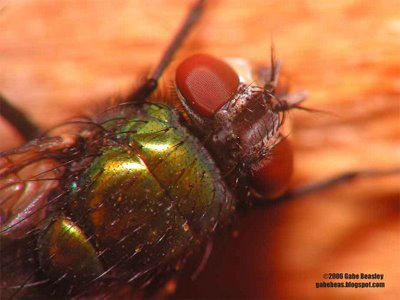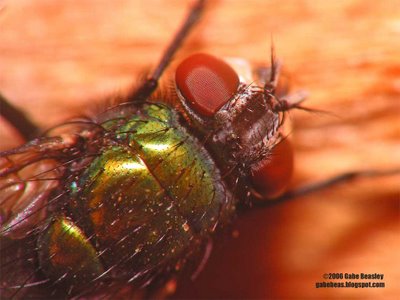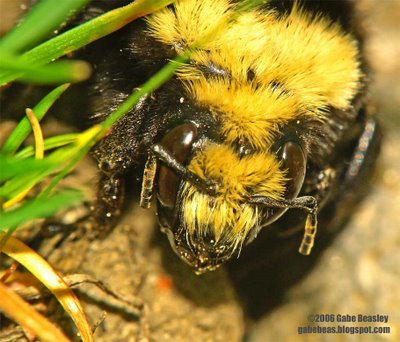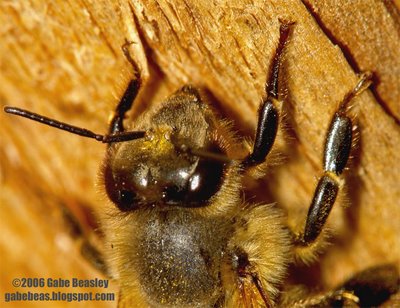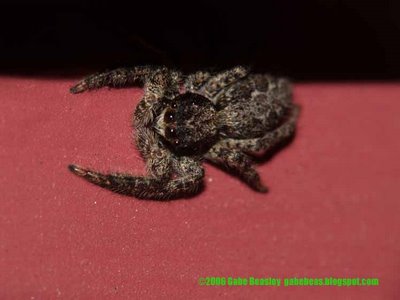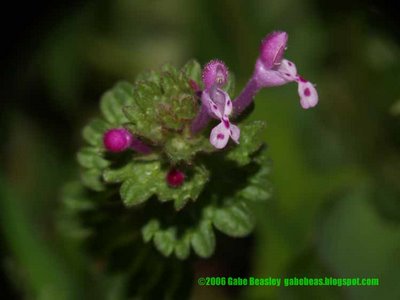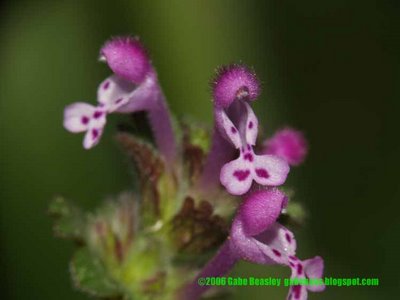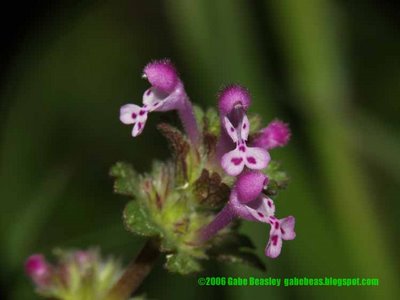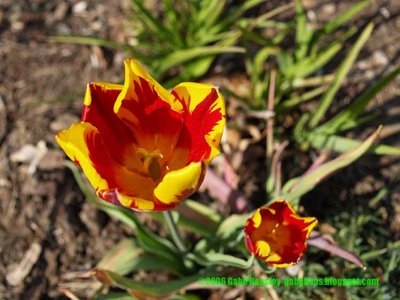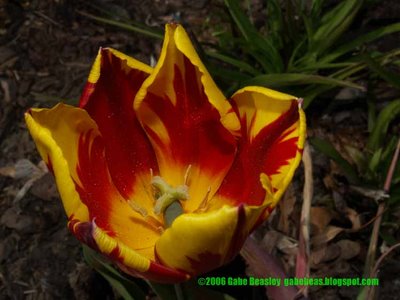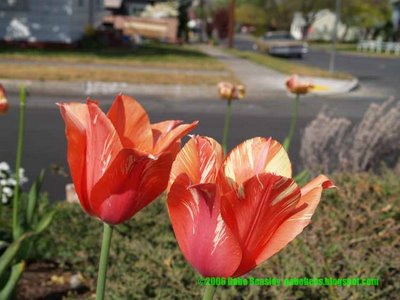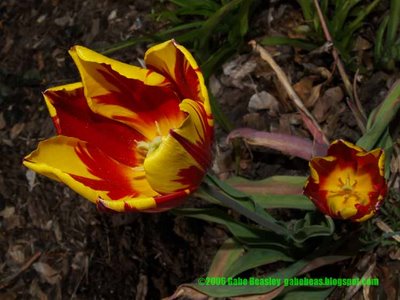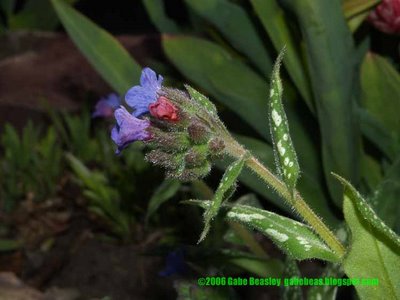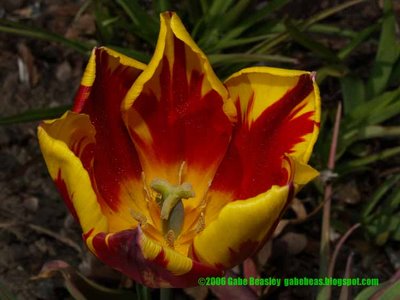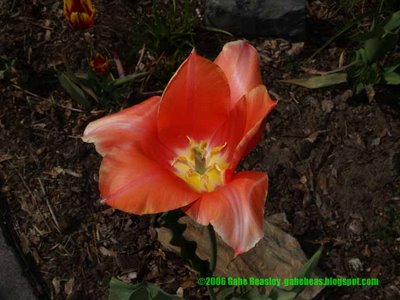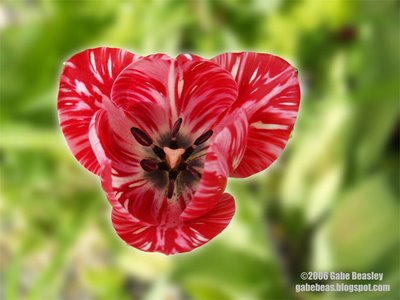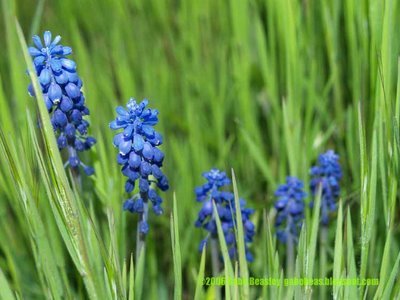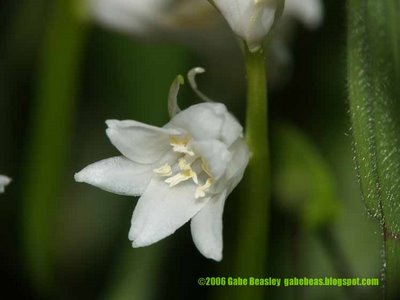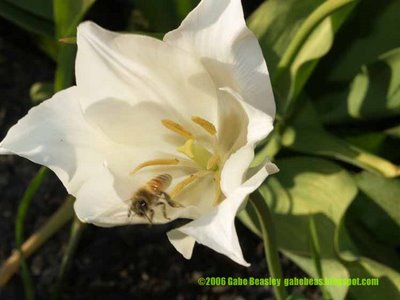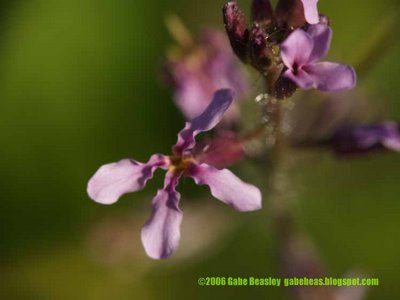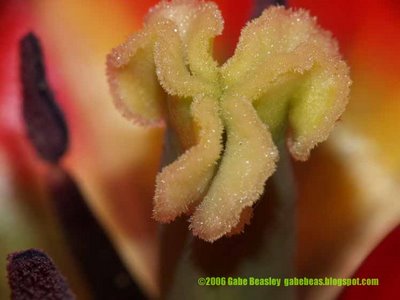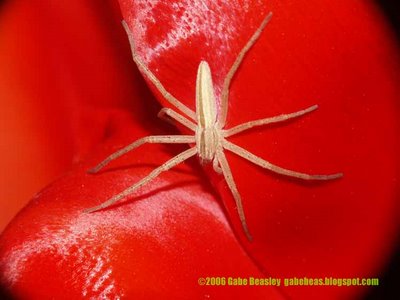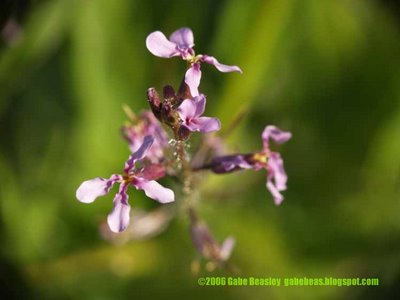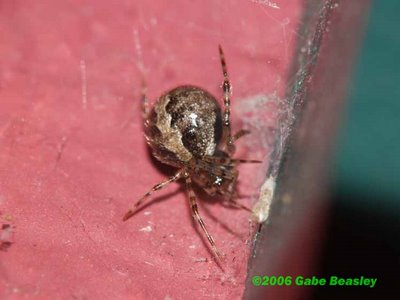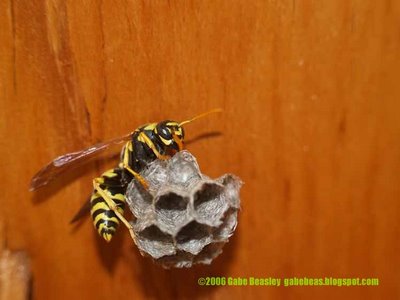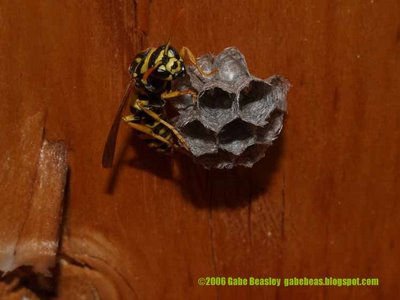 So what is it? A bee, or a fly. It's a Bee fly. A fly that looks like a bee so that it can confidently eat pollen and drink nectar without trouble. Yes crab spiders sometimes get them, as they do real bees, but the bee fly is made to look as dangerous as any bee or wasp. They have no such defenses.
So what is it? A bee, or a fly. It's a Bee fly. A fly that looks like a bee so that it can confidently eat pollen and drink nectar without trouble. Yes crab spiders sometimes get them, as they do real bees, but the bee fly is made to look as dangerous as any bee or wasp. They have no such defenses.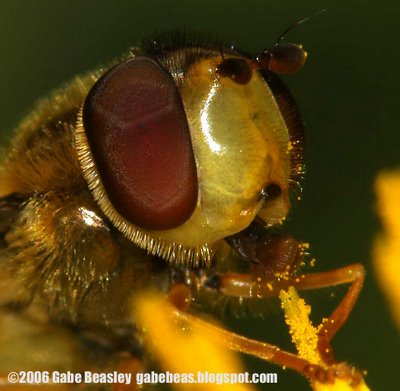 BE SURE TO CLICK ON THESE PICTURES--THEN CLICK ON IT AGAIN FOR MORE!
BE SURE TO CLICK ON THESE PICTURES--THEN CLICK ON IT AGAIN FOR MORE!(Use the <-back arrow in your internet explorer to get back to my site)
This is a crop of another picture, you can see it's mouthparts again covered in pollen. They do not live in hives or make honey--they simply fly from flower to flower feeding themselves as much as they can to stay alive. They may look like bees but have nothing in common with them socially.
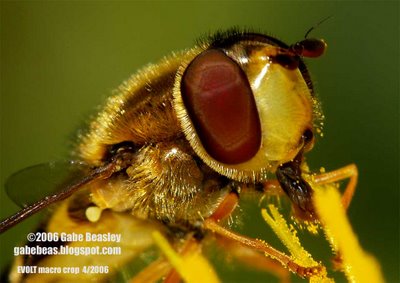 A third shot of the bee fly. Just ahead of my depth of field (the point furthest out from the head when things get a little blurry)--you can see the secret to insect flight. That is actually an ancient wing which looks in this picture like a spot or ball on a twig. It's just below the wing and right above where I wrote my last name (Beasley). That little thing is an organ which beats up and down as the insect flies. They are very sensitive and keep a sort of time--like the sensitive gyroscopes of rockets, they keep the flies mind naturally tuned to flight. Without these two swinging organs which can be more clearly seen in crane flies (I will post a picture of one later) almost all flying insects would be grounded. They act as sensors that I can best explain are kind of like our ears balance so we can ride a bike, only much more complex and of course instinctual. This way the motions of this flies wings are changed very slightly to make all the micro-corrections needed for flight. Scientists are working hard trying desperately to duplicate this kind of flight but last I heard they are still having a hard time. It's a big like a flight computer hooked to sensors that keep many modern aircraft able to fly only based on completely different systems. All flies have them, large and small, including the one below. This kind of sensor lets hover flies stay even in the wind entirely motionless. I used to get up every morning when I was a kid and watch the hover flies in the front yard sun-themselves. They seemed so easy to grab yet every time I tried they moved just a foot or two away and then right back into hovering faster then I could extend my hand completely. I have since been fascinated with how incredible insect flight is.
A third shot of the bee fly. Just ahead of my depth of field (the point furthest out from the head when things get a little blurry)--you can see the secret to insect flight. That is actually an ancient wing which looks in this picture like a spot or ball on a twig. It's just below the wing and right above where I wrote my last name (Beasley). That little thing is an organ which beats up and down as the insect flies. They are very sensitive and keep a sort of time--like the sensitive gyroscopes of rockets, they keep the flies mind naturally tuned to flight. Without these two swinging organs which can be more clearly seen in crane flies (I will post a picture of one later) almost all flying insects would be grounded. They act as sensors that I can best explain are kind of like our ears balance so we can ride a bike, only much more complex and of course instinctual. This way the motions of this flies wings are changed very slightly to make all the micro-corrections needed for flight. Scientists are working hard trying desperately to duplicate this kind of flight but last I heard they are still having a hard time. It's a big like a flight computer hooked to sensors that keep many modern aircraft able to fly only based on completely different systems. All flies have them, large and small, including the one below. This kind of sensor lets hover flies stay even in the wind entirely motionless. I used to get up every morning when I was a kid and watch the hover flies in the front yard sun-themselves. They seemed so easy to grab yet every time I tried they moved just a foot or two away and then right back into hovering faster then I could extend my hand completely. I have since been fascinated with how incredible insect flight is.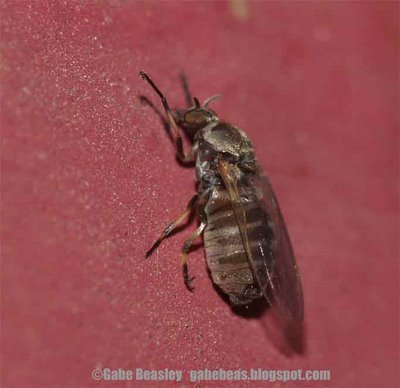 This tiny fly is almost surely ready to lay eggs. It's very small, too small to notice with the naked eye unless you really look. It came to my lights a few weeks ago. It's filled on something but I am unable to find any info on this very small macro species. I could not even tell where it's head was until I shot this extreme macro shot of it with my digital SLR.
This tiny fly is almost surely ready to lay eggs. It's very small, too small to notice with the naked eye unless you really look. It came to my lights a few weeks ago. It's filled on something but I am unable to find any info on this very small macro species. I could not even tell where it's head was until I shot this extreme macro shot of it with my digital SLR. A LITTLE ABOUT MACRO CAMERAS
A LITTLE ABOUT MACRO CAMERASAnother extreme Macro shot I got yesterday, this tiny baby jumper is only about 1.5mm long if that. It was too afraid for me to use my ruler. You can tell by my depth of field how small it is if you know what to look for. I was lucky to get this shot. This was done with a camera I put together I call the "X1". This macro level is too high for my macro lenses on my digital SLR. The shot had to be carefully guided because my depth of field was only about 1mm wide. These kinds of shots push the limits of macro into the microscopic level. This tiny jumper will grow to be up to 1cm if it survives--but now it's so small that even other spiders would not notice it. By chance it caught my eye when I was taking a picture of a much bigger spider below. This new setup will let me bring you even higher definition macro shots then ever before. I can't wait to get some more pictures with this new setup I put together. The images are very clear because no cropping is needed. Even with an 8 or 12mp camera--you loose mega pixels seriously when you try to get macro shots by cropping larger shots. Most importantly more mega pixels is not the way to get more macro power. It does help to have more mega pixels but the key is magnification, good optics and good lighting. That's why you should buy a macro lens or setup and you can't just shoot everything with one lens even if you can do good close-up shots. Croping degradation is very visible in any sized camera. It's often more in the optics, the lenses your using--no matter if you have a 6, 8, or 12+ mega pixel digital SLR. I find that older Nikon lenses have a higher quality factor then the new stuff. The difference can be amazing. Here in this "X1" shot--the depth of field due to optics is so much better the small compact camera's f8 limit is not really a problem. There are a number of ways to build these kinds of "poor mans macro lenses" and camera rigs--often due to optical clarity 3.2mp or 4mp is actually plenty because no cropping or digital zooming is used. Digital zooming very quickly degrades the image so I rarely use it with my compacts and on the "X1" setup it's turned off.
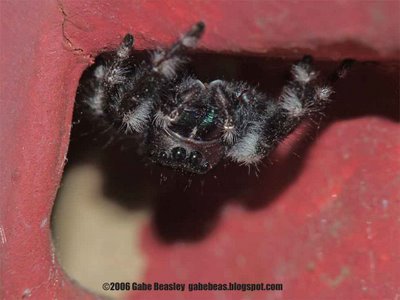 A black and white jumper and fully grown. There were two of them in what is like a condo for jumpers. This one is a different species then the baby one in the other picture above. I am surprised at how many were there as jumpers are somewhat territorial. The other one might have been a female. Only this one was brave enough to let me take it's picture. I got about ten shots before it finally crawled into this "cave" of paint until I could not see it anymore.
A black and white jumper and fully grown. There were two of them in what is like a condo for jumpers. This one is a different species then the baby one in the other picture above. I am surprised at how many were there as jumpers are somewhat territorial. The other one might have been a female. Only this one was brave enough to let me take it's picture. I got about ten shots before it finally crawled into this "cave" of paint until I could not see it anymore. It took me allot of waiting and good luck to catch honey bees in tulips. They apparently have little to offer the bees, so they don't visit them as much as the smaller flowers that are visited all the time. I got lucky enough to get about a half dozen shots in all. The new shots taken with my "X1" setup are not even on my computer yet. I have new macro power and more is coming. And the "X1" rig uses no duct tape! Or any other tape for that matter. A solid system that looks home-made but really works.
It took me allot of waiting and good luck to catch honey bees in tulips. They apparently have little to offer the bees, so they don't visit them as much as the smaller flowers that are visited all the time. I got lucky enough to get about a half dozen shots in all. The new shots taken with my "X1" setup are not even on my computer yet. I have new macro power and more is coming. And the "X1" rig uses no duct tape! Or any other tape for that matter. A solid system that looks home-made but really works.NOTE: I have been doing ALLOT of posts. That means in order to see this month's pictures you will quickly have to go under "all pictures" and go back. Be sure to check a month back if you want to make sure you see everything. I got busy again and am posting more--summer is here and I have my digital SLR. I have plans to buy another possibly better macro lens soon.
